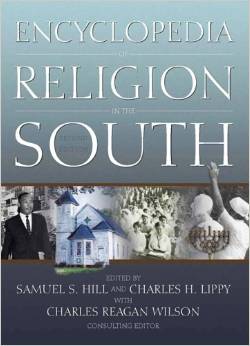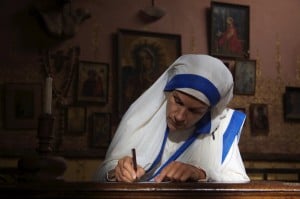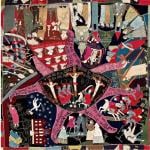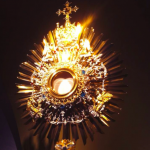Zounds! Boxes and packages show up in my mailbox and on my doorstep all the time. Since I do book reviews on my Catholic blog, publishers are happy to share their latest books hot-off-the-press, particularly in the field of religion.
 It is rare, though, that I find a package as heavy as the one which arrived this week from Mercer University Press. I was happy to receive the 864-page revised, updated and expanded Encyclopedia of Religion in the South. The editors are Samuel S. Hill and Charles H. Lippy.
It is rare, though, that I find a package as heavy as the one which arrived this week from Mercer University Press. I was happy to receive the 864-page revised, updated and expanded Encyclopedia of Religion in the South. The editors are Samuel S. Hill and Charles H. Lippy.
This beautiful book was originally published in 1984; the Revised Edition was updated and expanded in 2005 to reflect changes in demographics and cultural norms. The endorsement of Library Journal explains some of the important changes:
“This hefty reference work reflects the growth of studies in Southern Religion and satisfies the need for an accessible compendium of current knowledge of the subject. The denominational and institutional descriptions are admirably succinct and informative. The biographies are also brief and solid…. The good efforts to incorporate black religion into the regional picture demonstrate the progress in knowledge that has been made as well as the empty spaces that remain to be filled.”
The Encyclopedia of Religion in the South includes entries on denominations from Baptist to the Reformed Tradition, from the Society of Friends to Christian Methodist Episcopal.
There are entries on individuals from Oral Roberts to Pat Robertson to Robert Penn Warren.
In its pages, the reader can learn about sects such as Santeria and the Holiness Movement and Utopian communities, as well as more obscure practices such as snake handling.
There are so many articles which caught my eye, I know I’ll refer to the book again and again for research and information.
* * * * *
One concern I had, though, was that as a practicing Catholic, I found the section on my own faith, while truly striving for accuracy, to be imbued with a prejudice and lack of understanding about Catholicism. Let me explain:
The four-page entry on “Roman Catholicism” is excellent. Drawing on the insights of conservative Catholic writers such as Avery Dulles and John Hardon, as well as liberals Gustavo Gutierrez, Hans Kung, Richard McBrien and Karl Rahner, it portrays the Church accurately. For example, it avoids frequent Protestant objections to the papacy, explaining what “infallibility” is and is not:
“It is solemn Catholic teaching that the Pope is infallible, whether he teaches the church authoritatively as an individual or in concert with the other bishops of the church in an ecumenical council, on matters directly pertaining to faith or morals. The charisma of papal infallibility does not mean that the pope is impeccable (incapable of personal sin or error in conduct or thought) or a source of new revelation (the pope cannot create a new doctrine not already found in the historical witness of the Christian tradition or in the scriptures). Papal infallibility must be understood as an essentially negative charisma. It means that the pope in his role as supreme teacher of the church will not lead the church into error on a matter of what is to be believed as part of the deposit of faith or in a course of moral action. Catholic theologians, whether liberal or conservative, all agree that popes historically have exercised the charisma of personal infallibility most rarely in the course of the church’s history.”
I like this, actually. I think it accurately reflects the Catholic Church’s own understanding of infallibility doctrine.
However, in the 12-page entry on “Roman Catholicism (in the South)”, I found several comments which I considered to be inaccurate or prejudicial. The long list of references for that article includes only a few Catholics (i.e., Andrew Greeley, Tracy Ellis, Joseph Fichter), and none of the theologians I would like to have seen among consultants for the book.
Liberal Jesuit theologian Joseph Fichter, who favored a married priesthood and supported feminist causes, seems to be the originator of this problematic section (emphasis mine):
“In the South Catholics have remained both a numerical and a social minority. Unlike the Episcopalians and Presbyterians who were also numerical minorities in the region, Southern Catholics have never fully assimilated into Southern religious culture and styles. Catholicism includes too many non-English people, is subject to a foreign power, and its religious services differ from the Protestant norm. This is accentuated, as Joseph Fichter observes, by the fact that Catholic religious functionaries dress differently, do not marry, and are not hired by their congregations.”
To which I say, “So what’s your point?” Fichter’s prejudice against priestly celibacy, a discipline which could be changed but to which he was expected to adhere in his lifetime, is evident. And assimilation? This will not occur, and should not occur; and my reminder to the Baptist publishers is, “We were here first. If you want all to be the same, then come on home.” And “religious functionaries”? Those are priests. We call them “Father.”
As for the Catholic Church’s minority status, this remains true in the Deep South but there are suggestions that this may be changing. A Pew Forum Religious Landscape Survey in 2004 showed that Catholics in South Carolina, for example, numbered 8%. The numbers were somewhat lower in the most fundamentalist states (5% in Alabama, 5% in Arkansas), but higher in a number of states (24% in Texas, 26% in Florida, and 28% in Louisiana).
In total, Pew Forum researcher Greg Smith reported that in 2007, 15% of Southerners interviewed self-identified as Catholic; that number had increased slightly in 2008 to 16%.
Those statistics make Catholics seem a minority group when “Evangelical Protestants” are lumped together. Break out the Protestant denominations into Southern Baptist, Methodist, Lutheran, Assembly of God, multiple independent churches, and other evangelical and fundamentalist denominations, and the difference is less obvious.
Here’s another quote which leads me to question the objectivity of the writer:
“As the highest executive in the diocese, the bishop is personally responsible for all Catholic units in his territory. Southern bishops are overburdened with administration, largely because of poor management.
“…Overtaxed bishops have developed “bricks and mortar” mentalities preoccupied with internal ecclesiastical and financial matters and wary of involvement in potentially distracting and disruptive social issues.”
Again, I suggest that this was written by someone with an axe to grind, someone who had a decided prejudice against the Catholic Church’s way of doing business. The hierarchical structure of the Catholic Church seems unwieldy, perhaps, to writers for whom each church, each pastor is spiritual leader of his single congregation; but what’s wrong with having pastors at local level preaching and teaching, while the bishop retains responsibility for teaching all? And while bishops are, in fact, concerned about “bricks and mortar,” their primary responsibility is as leaders of souls.
Another line which I thought could well have been restated:
“Catholics joined in the Southern mania of college building in the 19th century, although most of their schools were little more than academies and many were short-lived.”
By my count, there are at least 197 Catholic colleges and universities in the United States–many of them in the South. The Catholic Intellectual Tradition has supported the arts and sciences and has spawned the development of universities world-wide. If some Catholic endeavors are “little more than academies,” perhaps that’s because others are not–and there is need in the world for both accredited universities and other programs of education. Don’t the Protestant denominations have, for example, bible studies which are unaccredited but which fill a valuable need among their adherents? This seems a cheap shot coming from a source book which aspires to objectivity.
One last grouse, if I may: The editors repeatedly refer to Catholic priests, who may have been educated in seminaries in the North, as “carpetbaggers.” The term is derisive, implying that the men who devoted their lives to the Gospel were, in fact, intending to profit from the instability and power vacuum that existed in the South following the Civil War.
But despite the red flags in their coverage of the Catholic Church, this is a reference work which any serious scholar of religion will appreciate.











